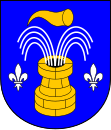Stašov
| Stašov | ||||
|---|---|---|---|---|
|
||||
| Basic data | ||||
| State : |
|
|||
| Region : | Pardubický kraj | |||
| District : | Svitavy | |||
| Area : | 1326 ha | |||
| Geographic location : | 49 ° 41 ' N , 16 ° 22' E | |||
| Height: | 585 m nm | |||
| Residents : | 263 (Jan. 1, 2019) | |||
| Postal code : | 572 01 | |||
| traffic | ||||
| Street: | Polička - Svojanov | |||
| Railway connection: | Prague – Plzeň | |||
| structure | ||||
| Status: | local community | |||
| Districts: | 1 | |||
| administration | ||||
| Mayor : | Miroslav Frodl (as of 2008) | |||
| Address: | Stašov 6 572 01 Polička |
|||
| Municipality number: | 578801 | |||
| Website : | www.obec-stasov.cz | |||
Stašov (German Dittersbach ) is a municipality in the Czech Republic . It is located eleven kilometers southwest of the town of Svitavy and belongs to the Okres Svitavy .
geography
The forest hoof village extends in the Bohemian-Moravian Highlands in the upper valley of the Křetínka from its source to the south. To the west rises the Baldský vrch ( Findeis ; 692 m), on the slope of which a cascade of 13 fish ponds is laid out. Velký stašovský rybník, located in the center of the village, is the largest with five hectares. In the northeast lies the Drašarov ( Draschenberg ; 686 m).
Neighboring towns are Květná and Borová Krčma in the north, Radiměř in the northeast, Rohozná and Manova Lhota in the southeast, Hamry and Čtyří Dvory in the south, Jedlová in the southwest, Balda in the west and Pomezí in the northwest.
history
The village, named after a locator named Dietrich, was first mentioned in 1557 when the Svojanov castle rule was divided. Dittersdorf belonged to the Laubendorfer part and at that time owned a wooden church which was a branch of Laubendorf . In 1650 the Záruba von Hustířan family became the owners of the village. In the 17th century a mineral spring was discovered during the search for gold on the western slope of the Findeisberg. After Jakob Hannibal III. Imperial Count von Hohenems had acquired the rule of Svojanov, he joined it in 1710 as an entails commission to Bistrau . Franz Rudolf von Hohenems had the first bath house and an inn built at the mineral spring in 1740. This resulted in the Bad Waldbrunn, which was later named Goldbrunn. Subsequently, a castle was built in Goldbrunn, which the owners of the estate only used for temporary bathing stays. With funds from the Religionsfonds, a separate parish was set up in Dittersbach in 1788. In 1828 the barons of Langet acquired bistrau from the imperial counts of Hohenems. Dittersbach remained part of the Fideikommissherrschaft Bistrau until the patrimonial rule was abolished.
From 1850 Dittersbach / Staršov formed a municipality in the Polička district; Goldbrunn belonged to Schönbrunn . In 1869 the castle in Goldbrunn was converted into a public bathhouse. In the following years the bathing business flourished in Goldbrunn and the guests included u. a. Jaroslav Vrchlický . A second bath was built near the old bath, the New Waldl / Nová Balda. In 1921 the Czech name of the municipality was changed to Stašov. In 1930 there were 1,090 people living in Dittersbach, 1,014 of whom belonged to the German ethnic group. After the Munich Agreement , the village was added to the German Reich in 1938 and until 1945 it belonged to the district of Zwittau . After the end of the Second World War, the German residents were expelled from Stašov. At this time, the bathing business in Balda also went out. The facilities of the Zlatá studna Balda bath were neglected and between 1946 and 1947 some buildings, including the former castle, were demolished. In the course of the territorial reform, the Okres Polička was dissolved on January 1, 1961, since then Stašov has belonged to the Okres Svitavy and Balda was re-municipalityed.
On June 2, 1983, lightning struck the small tower of the church. In the resulting fire, the roof of the church was destroyed, the bells melted and both church towers collapsed. With the support of volunteers, the church was able to be restored during communist rule and consecrated on October 30, 1988 by the vicar capitular Karel Jonáš.
Stašov is an agricultural village; in the southern part there are two quarries.
Community structure
No districts are shown for the municipality of Stašov. The hamlet of Balda ( Goldbrunn ) belongs to Stašov .
Attractions
- Church of the Assumption of Mary, built in 1873 in place of a previous Baroque building that burned down in 1856
- Pilgrimage chapel Maria Schnee in Balda, built 1747–1748


